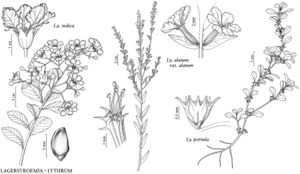Leaves 20–70 × 15–30 mm. Panicles showy, 5–25 cm. Flowers: floral-tube 7–10 × 6–10 mm; sepals erect; petals 10–12 × 7–15 mm, slender claw 7–8 mm; antisepalous stamens 6, stout, anthers green, relatively large, antipetalous stamens 30+, in clusters of 5 or 6, [rarely antipetalous stamens solitary], slender, anthers yellow, relatively small. Capsules globose to oblong, 9–15 × 8–11 mm. Seeds 7–9 mm, including unilateral wing. 2n = 48, 50 (China, India).
Phenology: Flowering summer–fall.
Habitat: introduced also widely in tropical and subtropical areas..
Elevation: 50–1000 m.
Distribution
Introduced; Fla., Ga., La., Miss., S.C., Tex., Utah, Asia, also widely in tropical and subtropical areas
Discussion
Lagerstroemia indica is popular in the southern and western United States as a landscape and street tree for its showy, densely flowered inflorescences. Numerous cultivars varying in habit and flower color have been developed. The dimorphic anthers of L. indica fill different reproductive roles. The larger, green anthers produce fertile pollen and the smaller, yellow anthers produce abundant, sterile pollen that attracts pollinators. A larger tree species, L. speciosa (Linnaeus) Persoon, is cultivated in southern Florida and southward; it has not become naturalized. It is distinguished from L. indica by oblong leaves to 28 cm and a yellow-brown puberulent, deeply ridged floral tube. Hybrid cultivars of the Japanese L. subcostata Koehne var. fauriei Hatusima × L. indica show a range of flower colors and habit and are increasingly popular in landscape use.
Selected References
None.
Lower Taxa
"dm" is not declared as a valid unit of measurement for this property."dm" is not declared as a valid unit of measurement for this property.
